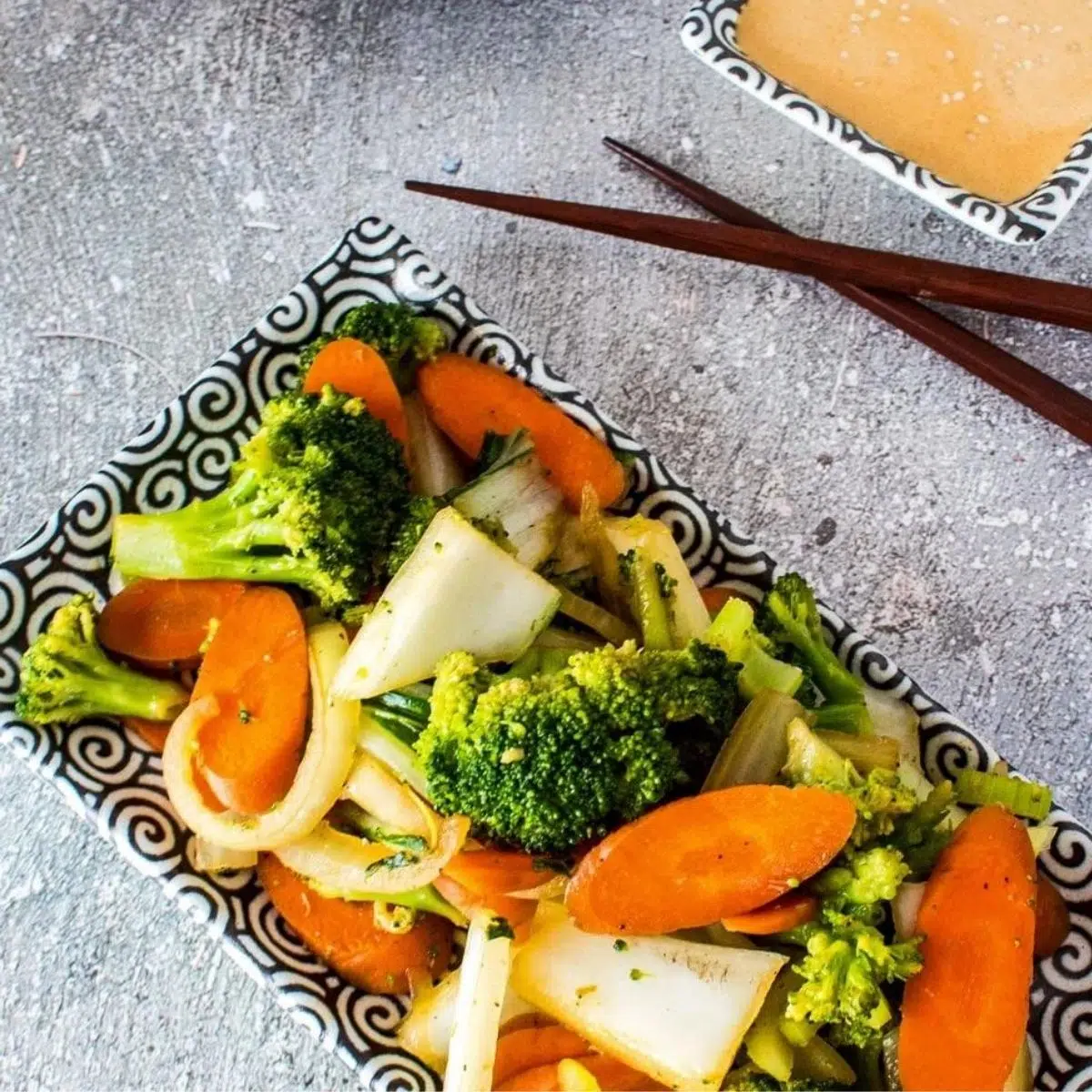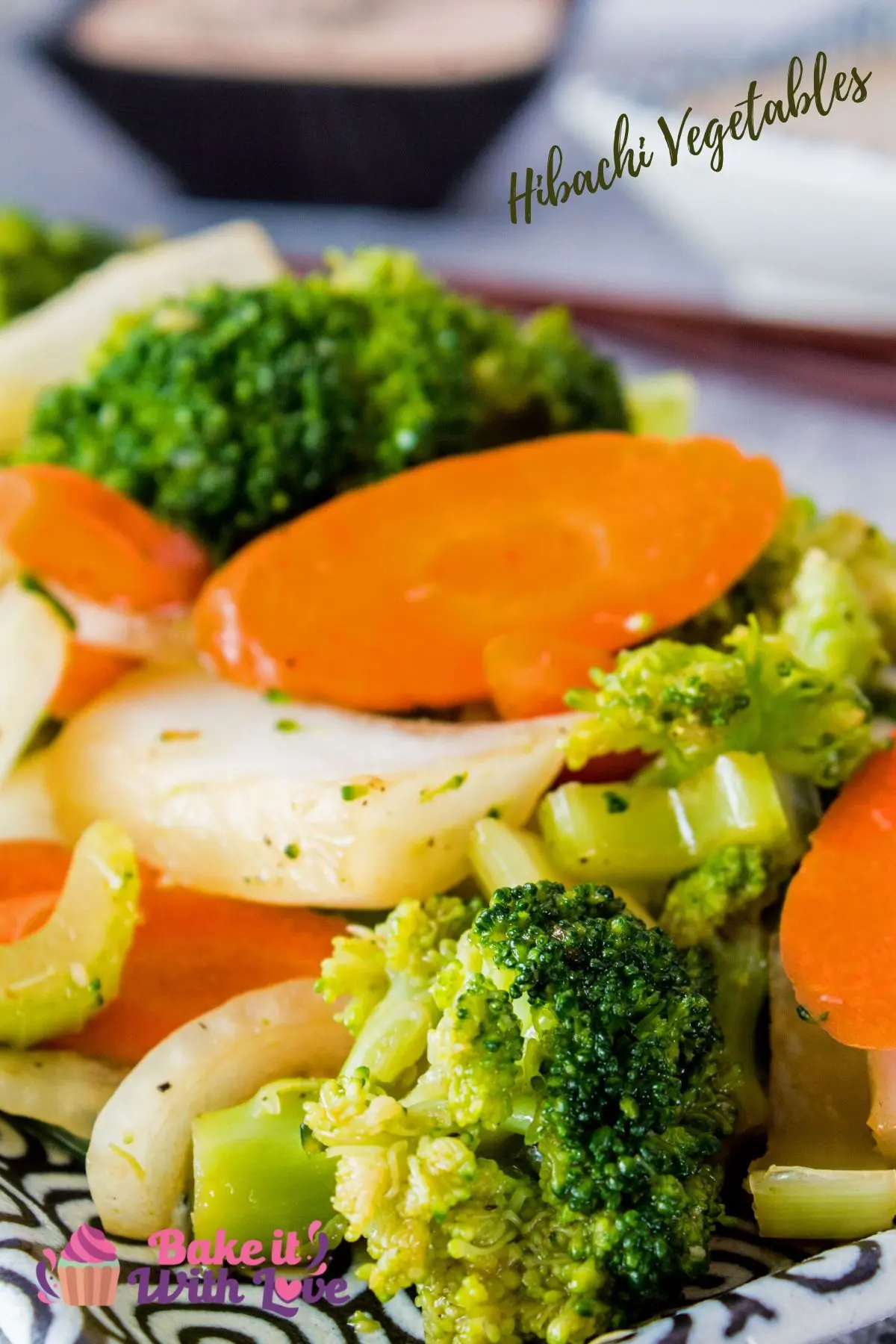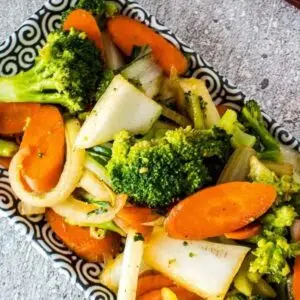Hibachi vegetables are easy to prepare, grilled to perfection, and make the most delicious side for your hibachi-style family dinners! Use your favorite vegetables, broccoli, carrots, celery, bok choy, and onion, as I do here! No matter which vegetables you choose, you'll have an amazing side dish that everyone will love!
Serve with hibachi steak and shrimp, salmon, scallops, or chicken!

Jump to:
These easy Japanese steakhouse-style Hibachi Vegetables are a tasty addition to any meal!
I've been busy adding all of our hibachi sauces (ginger dipping sauce, mustard cream sauce) and my other fabulous hibachi sides (hibachi noodles and hibachi fried rice) here on the blog.
If you love making quick and easy hibachi-style dinners at home, check out my article full of the best hibachi dinner and sauce recipes here!
🥘 Ingredients
In addition to the vegetables mentioned in the recipe here, I also like to add zucchini, snow peas, bean sprouts, mushrooms, green onion, water chestnuts, and yellow squash.
Use your favorite vegetables to make this vegetable side dish even better!
Hibachi Cooking Oil
- Sesame Seed Oil - 1 tablespoon of sesame seed oil.
- Olive Oil - 2 ½ tablespoons of olive oil (extra virgin).
- Rice Cooking Wine - ¼ cup of rice cooking wine.
- Soy Sauce - 2 tablespoons of soy sauce.
Hibachi Vegetables
- Garlic - 1 tablespoon of garlic (minced).
- Ginger - ½ tablespoon of ginger (fresh, peeled, and finely minced).
- Broccoli - 2 cups of broccoli (washed and chopped).
- Carrots - 3 medium carrots (washed and sliced).
- Celery - 4 ribs of celery (washed and sliced).
- Bok Choy - 3 leaves bok choy (washed and chopped).
- Onion - 1 medium white onion (quartered and sliced).
- Black Pepper - 1 teaspoon of black pepper.
- Lemon - juice from ½ of a lemon.
- Soy Sauce - 1 tablespoon of soy sauce.
- Butter - 1 tablespoon of butter (softened at room temperature).
- Sesame Seeds - as an optional garnish if you'd like.
*Be sure to see the free printable recipe card below for ingredients, exact amounts & instructions with tips!*
🔪 How To Make Hibachi Vegetables
These hibachi vegetables are incredibly easy to make and are ready to serve in under 15 minutes! You will need a Blackstone grill (an electric skillet or just a really large frying pan will work), some measuring utensils, and a knife set to get started.
This recipe will yield around 4 servings. You can easily scale up the ingredient list to make more if needed!
Making The Cooking Oil
This base cooking oil used by Japanese chefs is a combination of 4 basic ingredients. Hibachi cooking oil is made with sesame seed oil, olive oil, rice cooking wine, and soy sauce.
- Combine. Combine 1 tablespoon of sesame seed oil, 2 ½ tablespoons of olive oil, ¼ cup rice cooking wine, and 2 tablespoons soy sauce in a jar or squeeze bottle that you can seal with a lid to shake up the contents, and for storing any unused portion (if desired).
- Shake. Shake the container before using it to cook hibachi-style foods, such as hibachi vegetables, noodles, rice, chicken, steak, or seafood.
Cooking The Vegetables
- Prep. After washing and slicing your vegetables (2 cups of broccoli, 3 medium carrots, 4 ribs of celery, 3 leaves bok choy, and 1 medium white onion) bring a griddle surface, wok, or a large skillet with 2 tablespoons of the hibachi cooking oil to medium-high heat.
- Saute. Once the oil is shimmering, add the 1 tablespoon of garlic and ½ tablespoon of ginger and sauté for 2-3 minutes. Add the remaining vegetables (unless you are using bean sprouts or mushrooms, save them until the last two minutes of cooking time as they cook quickly), including chopped broccoli, sliced onion, sliced celery, sliced carrots, and chopped bok choy.
- Add ingredients. Add 1 teaspoon of freshly ground black pepper and some freshly squeezed lemon juice from ½ of a lemon. Continue to cook the vegetables over medium-high heat, adding more hibachi cooking oil as needed.
- Add ingredients. Combine 1 tablespoon of butter and 1 tablespoon of soy sauce then add to vegetables at the last 2 minutes of cooking. Cook until vegetables have reached your desired level of tenderness, about 5 minutes. *Use unsalted butter or low-sodium soy sauce if desired.
- Serve. Remove from heat and serve garnished with optional sesame seeds.
Don't forget to try some yum yum sauce for dipping. Enjoy!
💭 Angela's Pro Tips & Recipe Notes
- Using Pre-Sliced Vegetables: For convenience, feel free to use pre-sliced vegetables. This can save time and make the preparation process quicker and easier.
- Adjusting Broccoli Texture: If you prefer your broccoli to be crispier, add it towards the end of the cooking process. Similarly, for vegetables like bean sprouts or spinach that cook quickly, add them at the end and cook for just 1 minute.
- Adding Heat: To introduce some spiciness to the dish, consider using red pepper flakes or red chili sauce. Adjust the amount according to your heat preference.
- Butter for Smoothness: Adding a bit of butter at the end of cooking can make the vegetables extra smooth. It's a simple yet effective way to enhance the flavor and texture of your vegetable side dish.
🥡 Storing & Reheating
Refrigerate any leftover vegetables in an air-tight container, for up to 3 - 4 days. However, the vegetables are best used within the first day or two of being refrigerated.
Reheating
A quick stovetop heating is the best way to reheat your leftovers (the same is true of pretty much any take-out, homemade Chinese, or Japanese-style foods).
Heat a large skillet or wok on high heat, use a touch of my hibachi cooking oil, and turn the vegetables for about 2 minutes or until they are heated through completely.

>>>>See all of my recipes here<<<<
❓ Recipe FAQs
I recommend using a Blackstone grill or an electric skillet if you have one. If not, you can simply use a wok, cast iron skillet, or any large frying pan. It's important to work in batches if your vegetable won't fit all at once so that everything cooks through evenly and properly.
Of course! You can freeze these hibachi vegetables in a freezer-safe container or heavy-duty storage bag for up to 2 months! If you like to meal prep, this is a great dish to prepare ahead of time. Thaw them overnight and follow my reheating instructions above.
Hibachi-style includes meat, vegetables, rice, and noodles that are cooked quickly on high heat. Typically, a griddle is used to cook on, but the traditional way is a cylindrical shaped pan burning over hot coals. If you've ever been to a Japanese restaurant that serves hibachi, you've seen how entertaining the cooking can be.
🍱 More Hibachi Recipes
- Hibachi Fried Rice - My hibachi rice makes an excellent base for all of your favorite hibachi-style proteins!
- Hibachi Salmon - This hot and fresh salmon is perfectly grilled and ready to serve in 20 minutes!
- Hibachi Scallops - These delicious and easy-to-make hibachi scallops are seared to perfection with butter and lemon juice!
- Hibachi Chicken - Hibachi chicken is an easy chicken dinner that is full of tasty flavors!
- Hibachi Ginger Sauce - Serve this delicious ginger sauce with your favorite hibachi steak, seafood, chicken, or vegetables!
- Hibachi Noodles - These hibachi noodles are rich, buttery, smooth, and perfect as a base for many dishes!
Do you love a recipe you tried? Please leave a 5-star 🌟rating in the recipe card below and/or a review in the comments section further down the page.
Stay in touch with me through social media @ Pinterest, Facebook, Instagram, or Twitter! Subscribe to the newsletter today (no spam, I promise)! Don't forget to tag me when you try one of my recipes!
📖 Recipe Card
Hibachi Vegetables
Ingredients
Hibachi Cooking Oil
- 1 tablespoon sesame seed oil
- 2 ½ tablespoon olive oil (extra virgin)
- ¼ cup rice cooking wine
- 2 tablespoon soy sauce
Hibachi Vegetables
- 1 tablespoon garlic (minced)
- ½ tablespoon ginger (fresh, peeled and finely minced)
- 2 cups broccoli (washed and chopped)
- 3 medium carrots (washed and sliced)
- 4 ribs celery (washed and sliced)
- 3 leaves bok choy (washed and chopped)
- 1 medium white onion (quartered and sliced)
- 1 teaspoon black pepper
- ½ lemon
- 1 tablespoon soy sauce
- 1 tablespoon butter (softened at room temperature)
- sesame seeds (optional, garnish)
(Note: 2x or 3x only changes the ingredient list)
Instructions
Hibachi Cooking Oil
- Combine ingredients in a jar or squeeze bottle that you can seal with a lid to shake up the contents, and for storing any unused portion (if desired).
- Shake container before using to cook hibachi style foods, such as these hibachi vegetables, noodles, rice, chicken, steak, or seafood.
Hibachi Vegetables
- After preparing your vegetables, bring a griddle surface, wok, or a large skillet to medium high heat.
- Once the oil is shimmering, add the garlic and ginger and sauté for 2 - 3 minutes. Add the remaining vegetables ( unless you are using bean sprouts or mushrooms, save them until the last two minutes of cooking time as they cook quickly ) including chopped broccoli, sliced onion, sliced celery, sliced carrots, and chopped bok choy.
- Add freshly ground black pepper and some freshly squeezed lemon juice. Continue to cook the vegetables over medium high heat, adding more hibachi cooking oil as needed. *Use unsalted butter or low sodium soy sauce, if desired.
- Remove from heat and serve garnished with optional sesame seeds.




Karl says
Super easy to follow recipe. A great side dish and the hibachi oil was fantastic!
Angela @ BakeItWithLove.com says
Awesome! So glad you enjoyed the veggies!
Kim says
This was delicious and best homemade hibachi sauce I’ve tried! I tried it with brussel sprouts and roasted them in the oven before bringing it to the stovetop.